#Pleistocene megafauna
Text
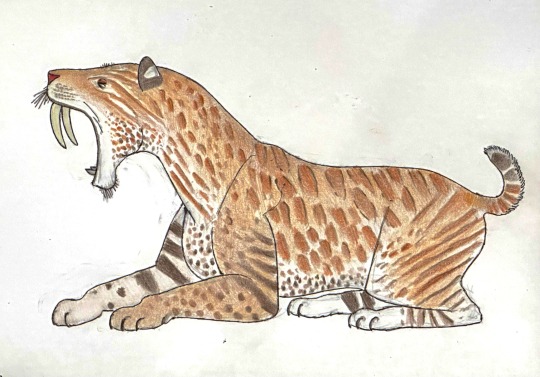
Color pencil-and-ink impression of Smilodon fatalis, the main North American species of the saber-tooth-cat genus Smilodon
#paleoart#mammal paleontology#paleontology#smilodon#smilodonfatalis#cenozoology#cenozoic life#cenozoic#paleoillustration#pleistocene#pleistocene megafauna
140 notes
·
View notes
Text
Eternally mad that I will never get to see a Channel Islands Pygmy Mammoth.
90 notes
·
View notes
Text
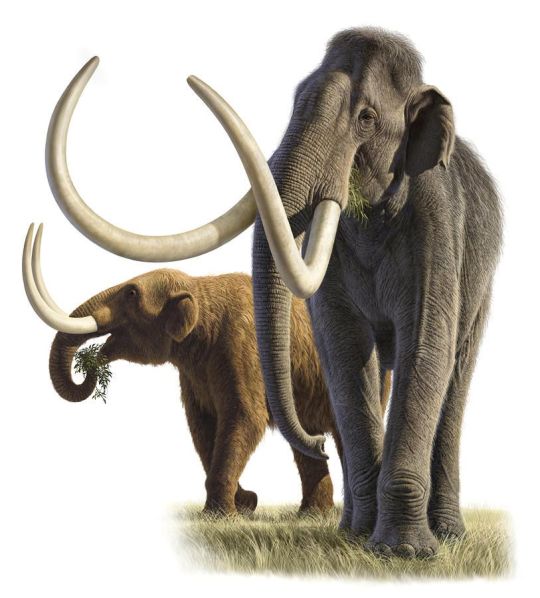
MEGAFAUNA OF NORTH AMERICA -- THE MAMMOTHS OF THE WEST.
PIC INFO: Spotlight on a Columbian mammoth (Mammuthus columbi), a species of mammutidae reportedly much larger and taller than the woolly variety, and a mastodon is in the background. Mastodon's generally had a browsing diet, distinct from that of the contemporary Columbian mammoth, which tended towards grazing. Artwork by Raúl Martín.
EXTINCTION: Both species disappeared from North America as part of a mass extinction of most of the Pleistocene megafauna, widely believed to have been caused by a combination of climate changes at the end of the Pleistocene and overexploitation by Paleo-Indians, c. 11,000 years ago.
Source: https://dinotoyblog.com/forum/index.php?topic=1887.20.
#Columbian Mammoth#Mammutidae#Mammuthus columbi#Mammuthus#Pleistocene Megafauna#Megafauna#Mammoth#Mastodon#Holocene#Prehistoric Animals#Prehistoric Beasts#Prehistory#Prehistoric#Mammoths#Palaeo Art#Paleo Art#Proboscideans#Elephantidae#Prehistoric Elephants#Pleistocene Epoch#Mega Mammals
4 notes
·
View notes
Text
Sometimes you just have to infodump about cave bears
#I don't even know that much about them but like#cave bears man#did you know some people theorize they were pack animals because we find them in such high densities?#imagine a pack of 9 foot tall bears how fucked up is that?#cave bear#palentology#pleistocene megafauna
1 note
·
View note
Text
D'you ever just... research North American megafauna that went extinct at the end of the Pleistocene, wondering what we might have been able to domesticate?
Like, there were numerous species of equus, and we might've already had the dog when First Nations peoples showed up, but what about more exotic animals? The North American camel or lamines, perhaps? Or one of the other species of bison or muskoxen?
Or, if we really get crazy, maybe one of the many ground sloths? The glyptodonts? The macrauchenia or the toxodon?
C'mon, I know it's not just me.
0 notes
Text


Two cave art inspired Megaloceros bucks creating their own thunder in the grass. This is a subsection of something bigger I was trying, but this is lovely on its own.
The noise and swirling faint patterns are anti-AI measures and are not present on the actual art print.
#art#palaeo#drawing#palaeosinensis#paleopanthera#illustration#digital art#painting#cave art#pleistocene#stone age#ice age#fossil#fossils#megaloceros#irish elk#megafauna#deer#buck#antlers#rut#fighting#paleo art#reconstruction#paleontology#cave painting
310 notes
·
View notes
Text
anyone else out here missing the megafauna of the pleistocene?
184 notes
·
View notes
Text
Animal of the Day!
Eurasian Aurochs (Bos primigenius)

(Photo from Britannica)
Extinction Date- 1627
Habitat- Europe; Northern Africa; Central Asia
Size (Weight/Length)- 1,000 kg; 1.8 m tall
Diet- Grasses; Nuts; Leaves
Cool Facts- The Eurasian aurochs was a majestic species of megafauna cattle that lived throughout the Pleistocene. Aurochs were believed to live in small herds and have a similar hierarchy to their current descendents of domesticated cattle. Due to their massive size, Eurasian aurochs had little to fear outside of prides of lions or large tigers. Their cultural significance travels throughout the Neolithic peoples of Asia, Africa, and Europe. Aurochs were favored creatures for cave paintings and fights in the Roman Colosseum. Domestication of aurochs began in the Fertile Crescent when humans began civilization. Unfortunately, Eurasian aurochs were driven to extinction by over-hunting and a quickly transforming landscape that resulted in the death of many megafauna species. Today, their closest relative is the rare, Spanish Pajuna cattle.
Rating- 12/10 (The loss of prehistoric landscapes resulted in the loss of megafauna worldwide.)
#animal of the day#animals#mammals#megafauna#Pleistocene#sunday#october 1#eurasian aurochs#aurochs#biology#science#conservation#the more you know#extinct#skeleton#fossil#but not really#subfossil#extinctober#pajuna cattle
326 notes
·
View notes
Text

Tiliqua fragnens was a heavily armoured extinct Pliocene - Pleistocene Australian lizard that was the largest known skink! She has emerged from winter brumation to eat the spring wildflowers :)
#lizard#reptile#palaeoart#paleoart#skink#Tiliqua fragnens#megafauna#pliocene#pleistocene#wildflowers#my favourite wildflowers :)
250 notes
·
View notes
Text

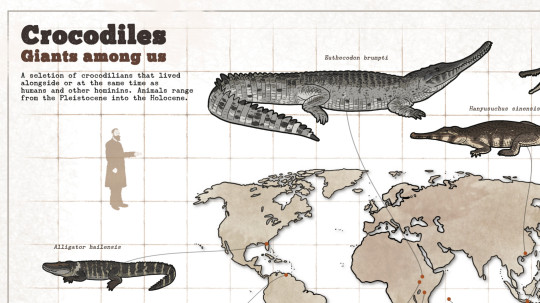
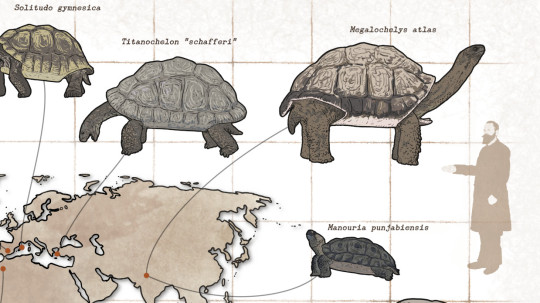


Some of my works appear on @252mya, this series is a recent contribution. On 4 posters I explored the diversity of several groups during the Pleistocene into the Holocene. Birds, Tortoises, Crocodiles and Elephants were the subjects of these initial posters, more might be added in the future.
It is Incredible to see how much megafauna we JUST missed.
#paleoart#sciart#birds#tortoise#turtle#elephant#fossils#pleistocene#ice age#extinction#among us#megafauna#mammuth#mammut#crocodile#mastodon#moa
519 notes
·
View notes
Text

A Jaguar (Panthera onca augusta) attempts to take down a Harlan's Ground Sloth (Paramylodon harlani) in Southwestern North America
#paleoart#paleoartist#animals#fossils#extinct#sciart#paleontology#iceage#3dart#blender#art#wildlife#biology#zoology#prehistoric#jaguar#bigcats#sloths#pleistocene#megafauna
68 notes
·
View notes
Text
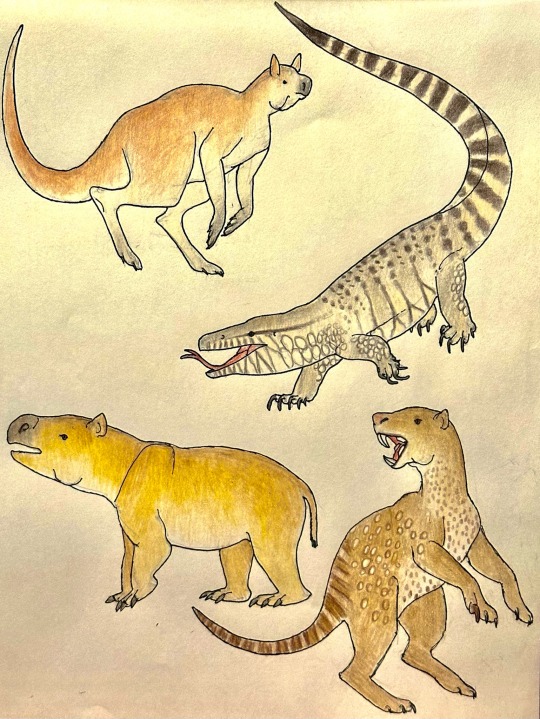
Sketches of the iconic Australian animals that were part of the Pleistocene Megafuana, from top to bottom: Procoptodon goliath, Megalania prisca, Diprotodon opatum and Thylacoleo carnifex.
#paleoart#paleontology#pleistocene#pleistocene megafauna#diprotodon#megalania#procoptodon#thylacoleo#australia#cenozoic#cenozoic life
45 notes
·
View notes
Text
Evidence gathered in a rock shelter in Brazil has thrown up compelling evidence for human occupation of South America as far back as 25,000 years ago, totally disrupting thinking on the migration of humans to the Americas.
#First Americans#South America#Brazil#pendants#migration#sloth#Pleistocene#megafauna#ancient#history#ancient origins
68 notes
·
View notes
Text

Hello my beloved tumblr mutual @little-mephistopheles absofuckinglutely.
The Aotearoa Moa is an extremely fucking large bird endemic to Aotearoa ("New Zealand"). Of all of the species of moa, the largest ones ranged to be as tall as 12ft and weigh over 500lbs. They were all flightless. Today the largest living flightless bird is the ostrich (just under 9ft, 345lbs approx). They were among the amazing megafauna to exist during the Pleistocene, including giant sloths, mammoth, and mastodon!

(X) (what the fuck is an elephant bird? an elephant bird is for another post, actually)
Something neat I found surprising about them is according to all available skeletal remains, they have no vestigial wing bones of any kind - unlike an ostrich, and even kiwi. Some bird they are, amirite? Also, no need to worry about them eating you - they were vegetarians, actually!
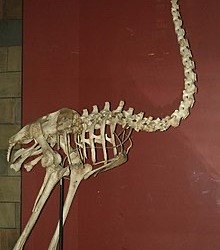

(moa skeleton with no wing bone at all total stud behavior versus ostrich skeleton with its stubby vestigial wing bones)
Prior to the arrival of the Maori people (which eventually led to their extinction by overhunting and egg foraging because big chicken big tasty), their only known predator was the Haast's eagle. The Haast's eagle was the largest known eagle to have ever existed. It weighed about 30lbs and had a wingspan of over 8 and a half feet.

(X)
The largest living eagle now is the Stellar's Sea Eagle, which boasts a similar wingspan but a slightly lower weight (females averaging 21lbs and males 13lbs). This means the moa an eagle might be hunting on a given day could have been up to 15 times it's own weight. What!!!
It's very fun to see these two in museum displays:
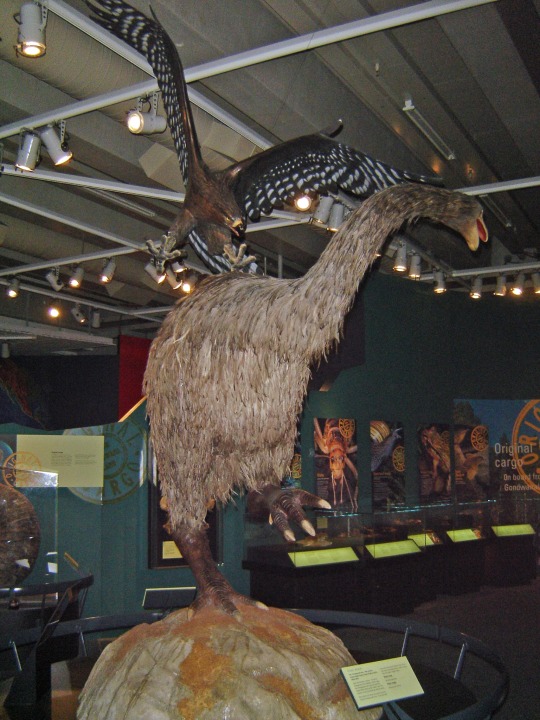
(X)
The Haast's eagle was eventually outcompeted by the Maori people, and declined to extinction after moa went extinct. Two birds . . . One stone . . . (I say, sobbing).
#bird#birds#alternate#New Zealand#extinct#pleistocene#megafauna#biology#ecology#history#wow#mutuals#asks#about me#31#little-mephistopheles
35 notes
·
View notes
Text




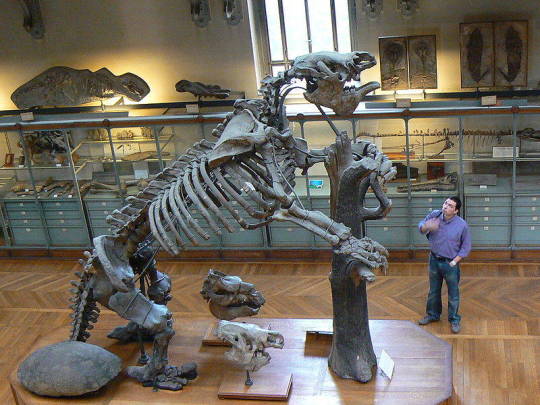
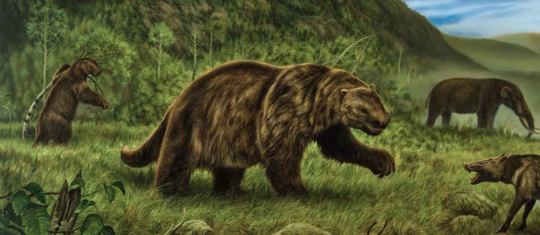


Megatherium known as the giant ground sloth or the megathere is an extinct genus of ground sloth which lived throughout South America from the Pliocene to Pleistocene some 5 million to 12,000 years ago. The first known remains of Megatherium consisting of a mostly complete skeleton were discovered in 1788 by Manuel Torres, on the bank of the Luján River in Argentina. The fossil was shipped to Museo Nacional de Ciencias Naturales in Madrid the following year, where it remains. It was reassembled by museum employee Juan Bautista Bru in 1795 and subsequently described by Georges Cuvier in 1796. Cuvier assigned the fossil the scientific name Megatherium americanum from the Greek méga 'great' and theríon 'beast' and americanum being a reference to the Americas. In the centuries to follow dozens of well preserved specimens have been recovered representing some 8 species considered valid: M. americanum, M. altiplanicum, M. gallardoi, M. istilarti, M. medinae, M. parodii, and M. sundti which are separated into the two sub-genuses of Megatherium and Pseudomegatherium. With the largest species reaching some 20ft (6m) in length, 7ft (2.1m) tall when on all fours, and 8,400 to 10,100lbs (3,810 to 4580kgs) in weight, megatherium surpassed most modern elephants in size making it not only one of the largest xenathrans but one of the largest mammals known to have ever existed. Megatherium had a robust skeleton with a large pelvic girdle and a broad muscular tail. Its large size enabled it to feed at heights unreachable by other contemporary herbivores. Rising on its powerful hind legs and using its tail to form a tripod, Megatherium could support its massive body weight while using the curved claws on its long forelegs to pull down branches. These large animals likely lived in small groups feeding during the day before spending there nights resting inside of caves and large burrows the animals likely dug using there massive claws. Megatherium became extinct around 12,000 years ago during the Quaternary extinction event, which also claimed most other large mammals throughout the world. The extinction coincides with the settlement of the Americas, and multiple kill sites where M. americanum was slaughtered and butchered, suggesting that human hunting helped caused the sloths extinction.
Art belongs to the following creators:
Megatherium Mother and Baby: Mark Witton
https://www.redbubble.com/i/art-board-print/Megatherium-by-MarkWitton/40411556.TR477
Megatherium: Brian Engh
Lost World - Megatherium: Rob Brunette
https://www.artstation.com/artwork/3dbQXY
#pleistocene pride#pleistocene#pliestocene pride#pliestocene#cenozoic#ice age#stone age#giant sloth#sloth#ground sloth#giant ground sloth#megatherium#pliocene#south america#megafauna#prehistoric#prehistoric animals
13 notes
·
View notes
Text

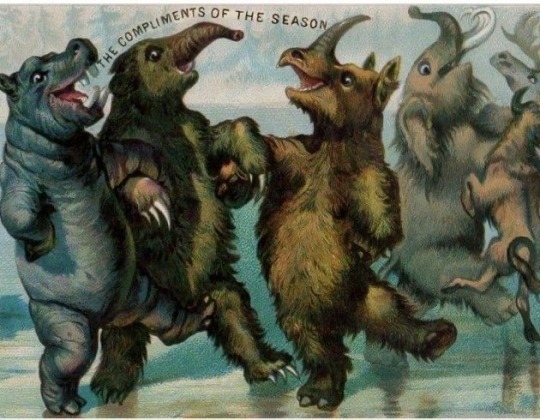
victorian era christmas cards featuring pleistocene megafauna by the de la rue company for the natural history museum of london
#victorian#vintage christmas#natural history museum#london#pleistocene#megafauna#antiques#paleontology#upl
15 notes
·
View notes